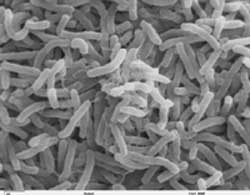A leap forward in understanding cholera

Caption: Scanning electron micropgaph of Vibrio cholerae. (Photo: Hartley et al.)
Cholera remains a public health problem in countries without access to safe drinking water and adequate sanitation. Researchers are trying to come up with theoretical models for cholera that allow them to understand how an outbreak happens, how it can best be contained, and how it might be prevented. Until now, the existing cholera models have not been able to describe and explain actual outbreaks very well. Taking new experimental data into account, David Hartley and colleagues (of the University of Maryland) now report a major advance in cholera modelling in the international open-access medical journal PLoS Medicine.
In 2002, Andrew Camilli and colleagues reported that cholera bacteria isolated from the stools of sick patients were much more infectious than those found in contaminated water. (They compared the two by exposing mice to a mix and determining which bacteria made the mice sick.) Those researchers proposed that the infection of a human patient (i.e., the exposure to an environment that is quite different from their regular freshwater ponds) changes the cholera bacteria. As a result, for a short period of time, the bacteria become more infectious.
The study caught the attention of David Hartley and colleagues, who saw a chance to improve the modeling of cholera epidemics. Hartley was interested because Camilli’s results shed new light on a fundamental question in cholera epidemiology: what is the relative importance of human-to-human infection(i.e. fecal to oral) versus environment-to-human infection (through contaminated food or water)? If the infective dose of bacteria that have become hyperinfectious because of recent passage through a human host is much lower than that of bacteria from the environment, this would support a crucial role of human-to-human transmission in cholera epidemics.
Hartley and colleagues found that incorporation of the existence of a hyperinfectious state into their models resulted in a much better fit with the observed explosive epidemic patterns of past cholera outbreaks. On one hand, this result lends theoretical support for Camilli’s results and suggests that his findings in laboratory animals have clinical relevance. On the other, it strongly suggests that human-to-human transmission is crucial for cholera epidemics and pandemics, and that health measures must focus on minimizing the risk of transmission of the short-lived hyperinfectious form of the bacterium. There is also the intriguing possibility that similar hyperinfectious states exist for other bacteria, something that seems well-worth exploring.
Media Contact
All latest news from the category: Life Sciences and Chemistry
Articles and reports from the Life Sciences and chemistry area deal with applied and basic research into modern biology, chemistry and human medicine.
Valuable information can be found on a range of life sciences fields including bacteriology, biochemistry, bionics, bioinformatics, biophysics, biotechnology, genetics, geobotany, human biology, marine biology, microbiology, molecular biology, cellular biology, zoology, bioinorganic chemistry, microchemistry and environmental chemistry.
Newest articles

Machine learning algorithm reveals long-theorized glass phase in crystal
Scientists have found evidence of an elusive, glassy phase of matter that emerges when a crystal’s perfect internal pattern is disrupted. X-ray technology and machine learning converge to shed light…

Mapping plant functional diversity from space
HKU ecologists revolutionize ecosystem monitoring with novel field-satellite integration. An international team of researchers, led by Professor Jin WU from the School of Biological Sciences at The University of Hong…

Inverters with constant full load capability
…enable an increase in the performance of electric drives. Overheating components significantly limit the performance of drivetrains in electric vehicles. Inverters in particular are subject to a high thermal load,…





















